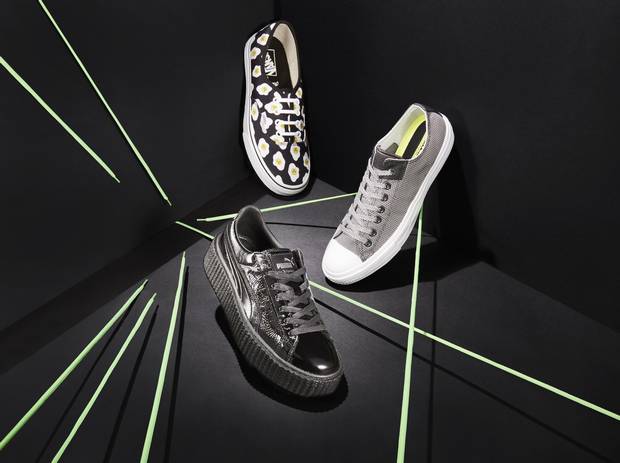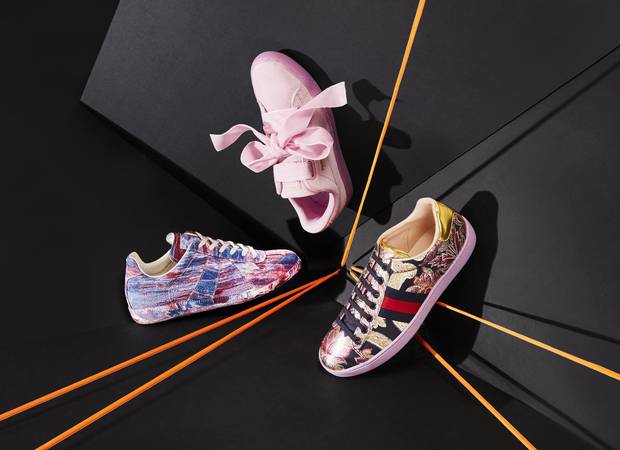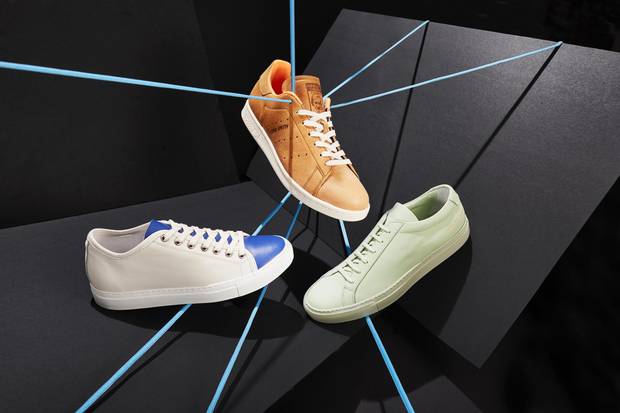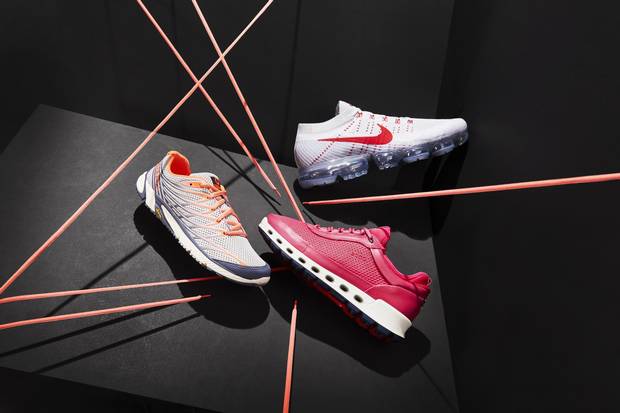"Power laces. Alright!" exclaims Marty McFly when he comes across self-lacing Nike Mag high-top sneakers in the circa-2015 fantasy world of Back to the Future II. Last year, Nike made these sneakers a reality with the HyperAdapt model, a replica of the make-believe shoe from the 1989 film, sold in a limited-edition release of 89 pairs. They were snagged by the lucky few who won an online draw – for $720 (U.S.) – while five pairs went to live auctions, with one set selling for a record-breaking $104,000 (U.S. ). But one doesn't need to look to fictional films to find a sneaker of the future. We are already there. "The performance footwear industry has always been at the forefront of innovation – it's where technology and coolness intersect," says Clare Varga, director of active – the department that predicts athletic apparel trends – at World Global Style Network, the world's leading trend forecaster. "But in the last five years advances in new materials and manufacturing techniques have utterly transformed modern sneaker design." Technologies such as 3D printing and 3D knitting have not only reimagined the fabrication process but also resulted in a lighter, higher-performance sneaker.

STREET FLEET: Many well-known lifestyle brands have tuned up their wares in recent years. In one of the most hyped fashion collaborations of the past few years, Rihanna’s partnership with Puma has resulted in an array of amped-up offerings including a glossy creeper style. Print artist Kendra Dandy teamed up with Vans to create a collection of cheerful, cartoonish products. And Converse has created the CT II, a comfier update on the brand’s most recognizable shoe, thanks to its plush Lunarlon foam insole. Clockwise from top: Vans x Kendra Dandy Sassy Side Up sneaker, $80 at Vans retailers ( www.vans.com). Converse Chuck Taylor All Star II OX basketweave sneaker, $85 at Hudson’s Bay (www.thebay.com). Fenty Puma by Rihanna Cracked Leather creeper, $210 at Gravity Pope (www.gravitypope.com).
Since the invention of the sneaker in the 1910s, the rubber sole was always made using a mould, but leading brands are starting to challenge the traditional process. "Moulds take months to put together; they're very expensive and time consuming. You've got to make them for every single size," says Bill McInnis, Reebok's head of future, the department that focuses on design innovation and development . McInnis, a former NASA engineer, spearheaded the Liquid Factory manufacturing lab in Lincoln, RI. Its first locally produced product, Reebok's Liquid Speed, launched last October with a limited run of 300 pairs that sold at $189.50 (U.S.) each. Up until then, the company's shoes were mostly manufactured in Asia. While the shoe still relies on a partially mould-shaped sole, the rest of it is 3D-drawn by robotics, resulting in a red liquid mesh that integrates the sole with the shoe's laces, providing a more secure fit. McInnis says the brand's next release will forgo the mould entirely. Regional production is also in the works for the future. "We're interested in getting to a more local-for-local solution," says McInnis. "That would be a global thing, not just here in the U.S. or just in Europe, but made in the U.S. for U.S., made in Germany for Europe, and automating that process and making it a lot faster than it currently is."
The desire for localized manufacturing is not only a reflection of recent tech innovations and an appetite for more sustainable production, but also of a highly demanding market. Thanks to the athleisure trend, which shows no signs of disappearing, research firm SportsOneSource finds the sneaker market now counts for $55-billion (U.S.) in international sales, showing 40 per cent growth since the mid-2000s. The rise of sneaker culture has seen the increase of sneakerheads, men and women who take sneaker collecting just as seriously as Carrie Bradshaw did her Manolos. The resale market is now estimated to be worth $1-billion (U.S.), as reported by the Financial Times. At press time, Reebok's Liquid Speed is listed for double its original retail value on eBay. Aside from looking cool, their desirability is driven by small production numbers and the search for transparency and authenticity in consumer culture among the millennials.

STEPPING OUTRE: Just because a sneaker is inherently sporty doesn’t mean you have to forgo fashion for function. Indulge in over-the-top accents and fabrics to give your downtime look a lift. Whether topped off by velvety bows like Puma’s charming gear or boasting Gucci’s wild metallic floral motif, these eye-catching styles are sure to put a spring in your step. Or try an artsy approach courtesy of Maison Margiela’s bold rubber runners. Clockwise from top: Puma Suede Heart sneaker, $109.99, Gucci Ace floral sneaker, $740 at Nordstrom ( www.nordstrom.com). Maison Margiela Tie-Dye Replica sneaker, $885 at Harry Rosen (www.harryrosen.com).
"Over the past several years, the design process has become faster, and personalization has become more important. We are investing in programs [that are] transforming what product we make and how we make it," says Claire Rankine, director of corporate communications at Nike Canada. The Oregon-based brand's eco-focused initiatives include Nike Grind, a palette of premium recycled materials used in 71 per cent of footwear and apparel, and ColorDry, a technology that dyes fabric without water. Since the introduction in 2012 of the Flyknit shoe, composed of a complex yarn weave made from recycled material that eliminated the need for traditional uppers, the company has reported a reduction of 3.5 million pounds of waste. Nike is partnering with Nova, a DreamWorks subsidiary, on a revolutionary 3D digital design system. Although the brand introduced 3D-printing technology in 2013 for a design of cleats, Nike's latest and most advanced shoe to date reimagines the traditional moulding technique. Released this April, Nike Air VaporMax's sole mould is composed of over 39,000 components, making it the company's most elaborate shoe to date. The clear singular sole eliminated the need for the foam layer used in the 30 years prior. "We discovered that we could create Air units that are flexible and place air in the spots where the runner needs it most," Jones explains. VaporMax won't have sneakerheads starting auction wars: It's widely available for $255.

SLEEK STREAK: The humble Stan Smith sneaker has enjoyed a chic revival thanks to the style set wearing them in droves during international fashion weeks. Equally subtle but natty options come from Belgian designer Sofie D’Hoore and Italian-American brand Common Projects. Look for pairs crafted from supple leather in mellow colourways for maximum impact. Clockwise from top: Adidas Originals Stan Smith sneaker, $170 at Davids ( www.davidsfootwear.com). Common Projects Original Achilles Low sneaker, $595 at Nordstrom. Sofie D’Hoore Frida sneaker, $645 at Gravity Pope.
Adidas's bid for the 3D-printed-sole shoe of the future came in the form of Futurecraft M.F.G. (Made For Germany), manufactured in its mostly machine-operated Speedfactory, which opened last year in Ansbach, Germany, thus returning some of the production back to Europe after 20 years of fabricating in Asia. The limited run of 500 pairs was distributed to family, friends and influencers to generate online hype before a mass release. This April, the company's Futures Team launched the Futurecraft 4D style, the first shoe in the world created by a new space-age manufacturing technology called Digital Light Synthesis. It's a breakthrough process pioneered by Carbon, one of the world's leading 3D printing companies, which uses digital light projection, oxygen-permeable optics and programmable liquid resins to generate 3D objects. Like the M.F.G., the first 300 pairs were given to friends and family – some wound up on eBay for upwards of $7,000 (U.S); 5,000 pairs will hit retail stores in the fall. The first American Speedfactory will open in Atlanta later this year.

TAILORED SWIFT: Give your run club something to talk about by donning a pair of souped-up running shoes: Merrell has equipped its Bare Access style with durable Vibram soles, while Nike’s new Air VaporMax production boasts custom-made machinery that tests each sole with the equivalent of running 400 miles. For those taking the slower track, Ecco’s Cool 2.0 GTX sneakers feature Gore-Tex® Surround™for optimal breathability for everyday wear. Clockwise from top: Nike Air VaporMax running shoe, $255 at Nike ( www.nike.com). Cool 2.0 GTX Textile running shoe, $250 at Ecco (www.eccocanada.com). Merrell Bare Access Arc 4 running shoe, $130 at Gravity Pope.
Under Armour is also bringing manufacturing back to America. Last summer, the brand introduced its Lighthouse space, a 35,000-square-foot facility in the brand's hometown of Baltimore, Md., where it produces futuristic 3D-printed footwear, such as last year's YA ArchiTech and this year's high-top follow up, the ArchiTech Futurist. Both limited-edition runs of 96 pairs retailed for $300 (U.S.) and sold out within minutes.
These coveted, small-run launches signal the next frontier of athletic sneakers. Bespoke fit is something that had been offered only to elite athletes thus far; 3D-printing technology allows for complete freedom to shape itself according to the 3D scan or measurements of one's foot, and thus customers don't have to rely on moulds made for a foot considered to be physically average. "That's a path that we're looking to go down," says Reebok's McInnis. But Varga forecasts the sneaker destiny far beyond that, beyond even what Marty McFly encountered back in 1989 – or, fake 2015. "Expect to see more responsive and intuitive footwear, designed to learn and react to movements and environments," she says. "Overall, though, comfort will be king."
Visit tgam.ca/newsletters to sign up for the Globe Style e-newsletter, your weekly digital guide to the players and trends influencing fashion, design and entertaining, plus shopping tips and inspiration for living well. And follow Globe Style on Instagram @globestyle.
